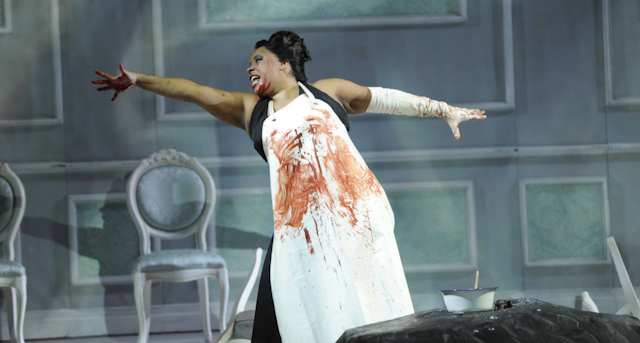When news of Rapture Theatre’s 2017 production of Tennessee Williams’ classic play A Streetcar Named Desire, reached one writer at The Herald newspaper, he penned a provocative piece under the headline: It’s hard to see Streetcar’s Stanley Kowalski as anything but white.
The reviewer argued that Stanley should be white because he is Polish, and Rapture’s casting of Joseph Black in the role was “anachronistic” and an example of indigestible colour-blind casting.

But, as Rapture pointed out in a robust response, Stanley’s ethnicity is not stated and it is plausible for him to be understood as black or of mixed racial ancestry without damaging any notions of authenticity or intent (should those elements even be desirable in the first place).
But even if Williams had explicitly stated that Stanley was white, should this mean that the character must only ever be performed by a white actor? Should Stanley only be performed by a white Polish actor for maximum realism? Of course not. But The Herald piece reminds us that the problem needs to be tackled from both sides of the footlights, addressing who is cast in which roles – and how those casting choices are received by audiences.
Contemporary casting practices
On their arrival at an event called Casting Race on Stage and Screen held at the Byre Theatre in St Andrews last month, 60 attendees were asked what they considered the single biggest obstacle to diversity and representation in contemporary casting practices, and the one factor most likely to address the problem.
A week later, they were invited to respond to the same questions. Initially, unconscious bias was deemed the major culprit; a week later it was a lack of representation on boards and councils. As for the solution, colour-conscious casting, which acknowledges difference, had a slight – then a significant – edge over colour-blind casting, with new repertoire (more contemporary subject matter that reflects a diversity of characters and experience), close behind.
Such debates are not new – and it is instructive to examine the past to see how far we have (or haven’t) come. We began by looking at the story of theatre and opera in the French colony of Saint-Domingue (now Haiti). Although this slave society was among the most racist and oppressive in human history, it featured two female actor-singers, Minette and Lise, who were of mixed African and European ancestry. The sisters forged solo careers in the 1780s, performing roles assumed to be white in front of mixed but segregated audiences. Both women represent an important step along the (as yet) incomplete journey towards diversity on stage.

We then turned to the more recent controversy over the casting of Zoe Saldana in the role of Nina Simone in Cynthia Mort’s biopic, Nina. Arguably, in purely theatrical terms, there is nothing wrong with Saldana wearing make-up and a prosthetic nose, but there were accusations of blacking up and questions about why a darker-skinned actor was not chosen. The answer for some was “colourism”, defined by Alice Walker as “prejudicial or preferential treatment of same-race people based solely on their color”.
The world of Western opera is probably the whitest of major performance genres. While theatre has had black Othellos in Shakespeare for decades (and now Iago and other roles too), the first black Otello in a major UK production of the Verdi opera was Ronald Samm in Birmingham in 2010. Samm has since played the role in a number of locations – but not yet at London’s Royal Opera House.

Bye bye blackface
Meanwhile, New York’s Metropolitan Opera finally abandoned skin-darkening make-up for the role in 2015. While this signalled the welcome demise of any vestiges of blackface, it was also problematic as an instance of colour-blind casting, for it legitimised giving the role to a white performer.
In October, the London premiere of a new opera, The Golden Dragon, set in a Chinese takeaway was pulled owing to a backlash over its all-white cast.

One of our two guests in St Andrews was African-American opera singer, Andrea Baker, who observed that as a mezzo-soprano, the operatic roles for which she is considered are typically “witches and bitches” and that modern audiences are usually able to “accept” an African-American singer in such roles. However, black, Asian and ethnic minority performers in the soprano lead remain rare.
Our second guest, British-born actor-director Satya Bhabha, is regularly confined to the “ethnic actor folder” – and usually to the Indian sub-folder. But Bhabha, who is half Parsi and half Jewish, and who is now American, reported that he had considered himself “not Indian enough” to have landed the role of Saleem Sinai in Deepa Mehta’s film adaptation of Midnight’s Children.
As a director, Bhabha acknowledges that increasing diversity and representation requires time, money and effort – and a conscious commitment to the cause. Michelle Terry, the new artistic director of Shakespeare’s Globe Theatre, has announced that under her leadership productions will be gender blind, race blind and disability blind. While this kind of commitment is welcome, it doesn’t address the limitations of blind casting or the problem of who makes it as far as the blind casting process in the first place.
Attendees at the Casting Race event were invited to choose between strategies, but together we can – and must – adopt a multifaceted approach that seeks to increase diversity and representation among audiences, playwrights, composers, directors and crew, as well as widening access to training, funding and representation on boards and councils. Perhaps then we shall see some real and lasting change.

